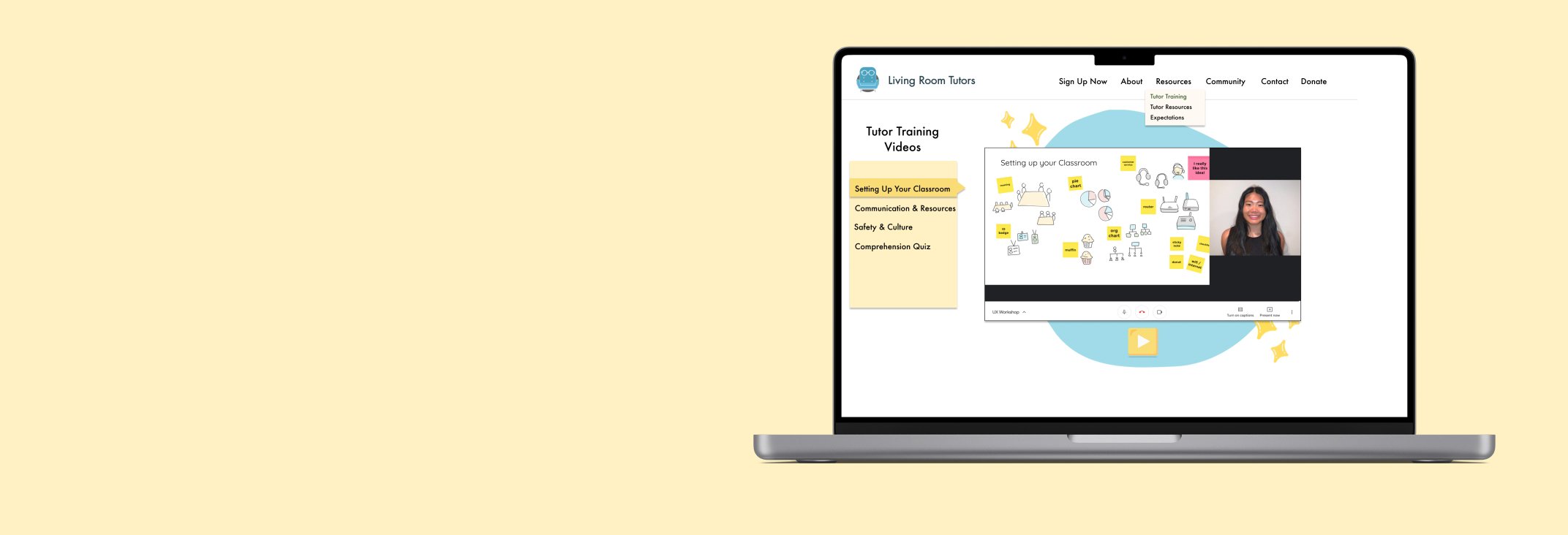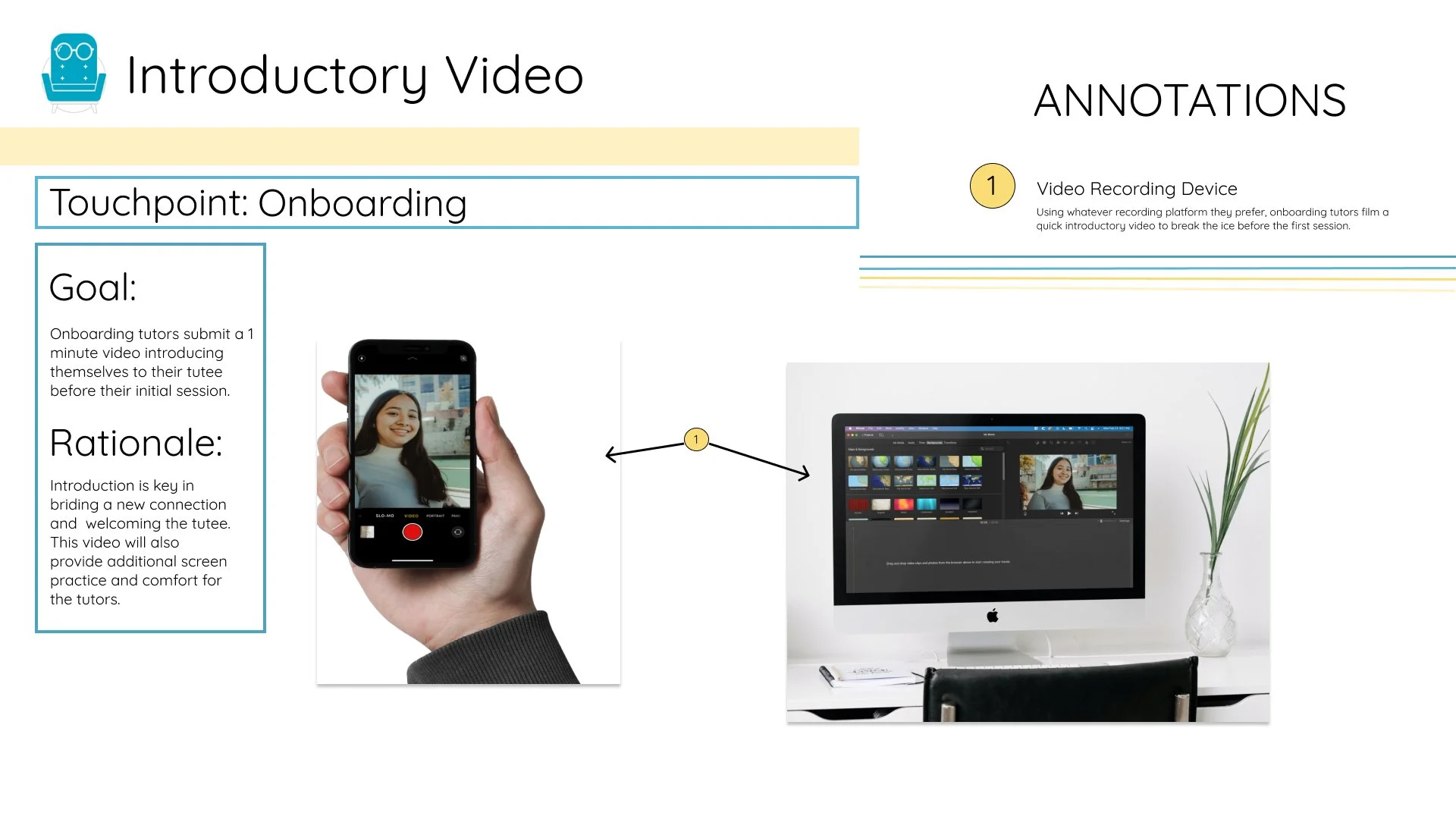
Living Room Tutors
Multi touchpoint strategy for a volunteer peer-to-peer academic support service
Scope & Deliverables
My team had the opportunity to develop a multi touchpoint strategy for this incredibly impactful and inspiration volunteer organization. Through the process, we addressed the following opportunity areas: A streamlined approach in outreach, onboarding and support processes.
Role: Researcher | Designer
Methodology: Know, Don’t Know, Assume | Competitive Audit | Secondary Research | Strategy Statement | Touchpoint Strategy Map | Annotated Wireframes | Video
Tools: Figma | Adobe | Excalidraw | Keynote | Google Suite
Team: Colleen Burke | Anne Kaune | Kendall Van Horne
The Challenge at Hand
How do children learn best? It can take years to learn how to effectively teach a class of 25 or more students. But many people can be trained in a relatively short time to be a good one-on-one tutor. Research has shown that peer-to-peer tutoring results in higher academic achievement, improved relationships with peers, improved personal and social development, and increased motivation.
The Client: Living Room Tutors (LRT) is a peer-to-peer tutoring service that was founded by Mayo High School student Jinglin Li. Her goal was to provide free, accessible tutoring services for students at the onset of COVID-19 after she saw the challenges her younger siblings and parents faced with remote learning. Now, less than 2 years later, Living Room Tutors has evolved to benefit almost 600 students across the country and continues to gain recognition. This rapid growth has revealed a need for increased support in building confidence and security among tutors and tutees alike.
Primary Users:
-High School and college aged students looking for volunteer opportunities in tutoring
- Parents of students looking for tutoring help
The Process
Know, Don’t Know, Assume
Upon initial review of Living Room Tutors website, my team noted any observations and questions we had about their site, outreach and training documents, and survey results that were provided by the stakeholders. It was a treat to We compiled a list of post-ts in a FigJam board under categories of Know, Don’t Know, and Assume. It was here we narrowed down topics and focus questions to help assist in the stakeholder interview.
Stakeholder Interview
We meet high school student Zoey, Living Room Tutors operations manager, virtually over a Zoom call. Through this interview we learn of the pure altruistic nature that this volunteer organization is structured upon while hearing of several pain points that have arisen due to their rapid growth. Solely run by high school volunteers, the current structure lends to the tedious work of manually matching tutors to tutees through email, a job that can put a lot of pressure and work on these busy young academics. Not only is this organization built on the compassionate desires of its volunteers, they are also operating on a very minimal budget with the value in mind that this remains a strictly free service. Relying on funding given by grants, LRT’s platform lacks specific requirements in order to receive these financial benefits. This interview was not only incredibly powerful and inspiring, but eye opening into the world of possibilities that strategic suggestion could provide for such a hard working and committed group of teens to help ensure success and confidence among the peer to peer community.
CLIENT GOAL: Creating free academic service opportunities that promote streamlined support, outreach and online safety to its users.
Secondary Research
The next phase of this journey was doing a bit of deep dive research, where I spent time surveying opportunities that addressed the following questions:
-"What exists in this space?"
-"How well does it work?"
-"What problems still exist?"
-"What’s important to the audience members/decision makers/influencers?"
-"Where/how are there opportunities to make a change to this experience?"
-"Are there similar experiences to learn from?
Putting myself in the seats of a high school volunteer, a concerned parent, and a struggling student, I built up a FigJam board with a collection of my findings. This included a series of user journey maps, references, notes and observations, zooming out to get a better idea of the scope of opportunity and possibility with currently existing touch points that the users may encounter. Main takeaways from this research highlighted that LRT is one of few peer to peer run organizations, but due to the age of its primary users, privacy concerns and policies are incredibly important to instill based on legality terms.
Guiding Strategy Statement:
As a team, we merged our findings into one board and set out to uncover a strategy statement that addressed our results. Using this secondary research as a foundation, we developed the following statement:
All user experience touch points for Living Room Tutors will help tutees and tutors to feel secure and/or supported and confident so that they are able to learn/practice new material and/or skills.
We will do this by focusing on creating a safe and reliable space through streamlined outreach and continuous training processes.
As a result we hope to see improved tutor and tutee engagement and academic performance, as measured by increased enrollment numbers and self-rated improvement scores.
Touchpoint Strategy Map
Leveraging personas of both a tutor and a tutee parent, as a team, we constructed a multi touchpoint journey map to highlight the users journey and engagement through LRT, noting any problem areas or holes where the journey may be disrupted. Personas were developed to help guide these journeys including : Generous Jen who is a high achieving student looking for volunteer opportunities to help build up her college applications and Concerned Katherine, a mother who’s son Henry, is in need of academic support after struggling through math during the virtual transition of schooling.
We noted these spaces of opportunity and developed a strategy of multiple touch points that addressed these questions. Individually, I assessed the transition from onboarding to support and created wireframes through Excalidraw.
Our main Touch points were:
-Outreach
How do the users currently hear about LRT and in what ways can we improve the visibility?-Onboarding:
What is the current process like, and how can it be streamlined into an efficient and easy process for the users?-Tutoring Support
How can the users feel supported and confident in their journey through LRT?-Turnover
What are processes that can smoothly transition volunteers out of the program and ensure that the tutees are continuing to receive support?
Touchpoint Journey Map created in Figma
Touchpoint Prototypes
Breaking away from my team, I assessed the possible user flow of the onboarding process and tutor support. Starting in low fidelity and translating those sketches into high fidelity annotated wireframes, I concluded the following suggestions to address these touch points. I created annotated wireframes with complete rationale behind each one to demonstrate the need and importance pertinent to the journey stages they applied to
Recommendation 1: Consolidating the training modules. As it currently stands, LRT emails their accepted tutors a hefty power point, left in the hands of the user to thoroughly read through. It’s incredibly open ended without any way of knowing if the onboarding tutor is reading through it and feeling a sense of preparedness.
Rationale: By creating a training video that includes the involvement of LRT volunteers that walks through the entire process of preparing for sessions, it will give the user a sense of confidence that they know what to do. To make sure the content was retained, a brief quiz that touches on the highlights of the video will be taken at the end and submitted to the portal.
Recommendation 2: Introductory Video. In an age where social media and screen time is prevalent more than ever, a brief introductory video is requested of the onboarding tutor to send to their match.
Rationale: Provide a sense of comfort to the parent of the potential tutee, it also provides a quick snap fo practice for the tutor to warm up in front of the screen before launching their first session.
Recommendation 3: Privacy Policy and Procedures Page
Making a Resources navigation tab and a readily available and easily accessible privacy policy page answers initial questions and concerns of both a parent and volunteer.
Rationale: These policies will provide a more transparent platform of expectations and understanding of the operations behind LRT for all parties involved.
Prototype Package
The most exciting part of this adventure was creating a presentation video that walked through the changes and suggestions our team made. A major deliverable item was this video that we efficiently put together as a team. I narrated the video and wrote the script to correspond with imagery frames Colleen put together using Figma storyboarding techniques. Kendall was the magician behind digitizing and syncing the sound and Annie constructed a final package that tied our findings together. It was such a delight to work through this project with a team that who effectively and efficiently work together, each with our own strengths that helped streamline an initially seemingly overwhelming project. The final product is one that we’re all proud of, especially given the quick time constraints of the deliverable. You can view the final video here:
Conclusion and Next Steps
This experience proved that in the field of UX, final outcomes can be more than imagery with wireframes. Strategy includes concepts that are not only digital, but physical as well. Working with a team that has a variety of strengths also proved insightful, as we clearly communicated challenges we were facing, opened our eyes to every possibility, and delegated tasks early on playing off of each others strengths. It was a rewarding experience that I gained a great deal of invaluable experience from and thus resulted in a strong deliverable at the end of our project.
To further demonstrate the future experience of Living Room Tutors, high fidelity prototypes are suggested to strengthen the website’s usability and flow in streamlining a process for the organization. Gaining user insight by carrying out usability tests to navigate any potential holes within the new suggestions would also further strengthen the experience.






